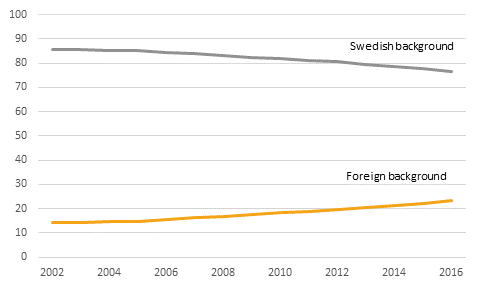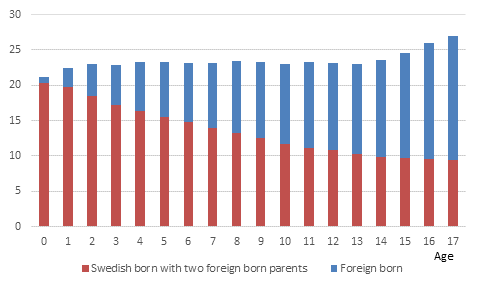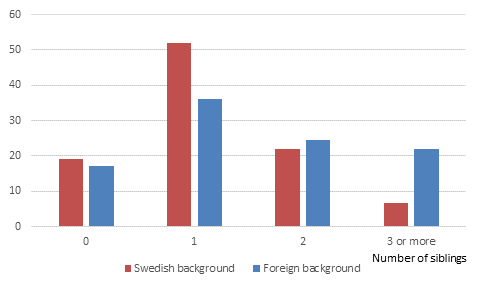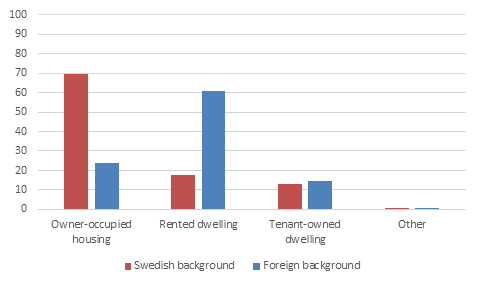Different living conditions for children with Swedish and with foreign background
Statistical news from Statistics Sweden 2017-06-29 9.30
Nearly one out of four children in Sweden have foreign background. Living conditions are different for children with foreign background than for children with Swedish background. For instance, it is more common for children with foreign background to live with a single parent and in a rented dwelling.
Among Sweden’s just over two million children aged below 18 years, 486 000 of them, or 23 percent, have foreign background. This is an increase from 2002, when the proportion was 14 percent.
The proportion of children aged 0–17 years with Swedish and with foreign background respectively, 2002–2016, in percent

The group “children with foreign background” includes children who are foreign born, and children who are Swedish born with two foreign born parents. Just under ten percent of children in Sweden are foreign born, and barely 14 percent are Swedish born with two foreign born parents. Among the youngest children, most of the children with foreign background are Swedish born with foreign born parents, while among older children it is more common for the child to be foreign born.
Syria, Somalia and Iraq are the most common countries of birth among foreign born children. These countries are also among the most common countries of birth for parents of children born in Sweden with two foreign born parents. Among these children, it is also common for their parents to be born in former Yugoslavia.
The proportion of all children aged 0–17 years who are foreign born or Swedish born with two foreign born parents, by age, 2016, in percent

The proportion of children with foreign background varies among Sweden’s municipalities. The lowest proportion is four percent in Lekeberg, in Örebro County and five percent in Hammarö, in Värmland County. Södertälje and Botkyrka, in Stockholm County, have the highest proportion of children with foreign background at 50 percent.
Municipalities with the lowest and highest percentage, respectively, of children with foreign background, 2016, in percent
| Lowest percentage | Highest percentage | |||
|---|---|---|---|---|
| Municipality | Percentage | Municipality | Percentage | |
| Lekeberg | 4 | Botkyrka | 50 | |
| Hammarö | 5 | Södertälje | 50 | |
| Öckerö | 6 | Malmö | 47 | |
| Söderköping | 7 | Burlöv | 43 | |
| Kungsbacka | 7 | Landskrona |
41 |
|
Separations, family and siblings
Living conditions differ among children with Swedish and with foreign background. For instance, it is more common for children with foreign background to experience their parents’ separation. Among children with foreign background whose parents lived together at the beginning of 2016, 4.4 percent experienced a separation during the year. Among children with Swedish background, the proportion was 3.4 percent.
A lower proportion of children with foreign background, 72 percent, live together with both of their original parents compared with 76 percent among children with Swedish background. Among children with foreign background, it is more common to live with a single mother, 19 percent compared with 13 percent among children with Swedish background. There is also a difference in the number of siblings. Living together with one sibling is most frequent among children with both Swedish and foreign background. However, it is considerably more common among the group with Swedish background at 52 percent compared with 36 percent among children with foreign background. Children with foreign background live together with three or more siblings to a greater extent than children with Swedish background.
The number of siblings living at home among children aged 0–17 years and living at home, by background, 2016, in percent

Housing
Among children with Swedish background, it is most common to live in owner-occupied housing, which 69 percent do. This can be compared with 24 percent among children with foreign background. Among children with foreign background, rented dwellings are the most common type of housing instead, which is how 61 percent of children with foreign background live, compared with 18 percent among children with Swedish background. Some of the differences in types of housing between children with Swedish and with foreign background can be explained by the fact that children with foreign background to a larger extent live in metropolitan areas, where a larger percentage of the dwelling stock consists of rented dwellings and where owner-occupied housing are less common. However, there are also differences within the same type of municipality between housing among children with foreign and with Swedish background respectively.
Type of housing among children aged 0–17 years living at home, by background, 2016, in percent

New statistics about children and families with children
The 2016 statistics on children and their families is now available in the Statistical Database. The statistics contain information on families with children, children’s type of family nucleus and siblings, adopted children, separations, housing and the finances of families with children.
Definitions and explanations
The statistics refer to children aged 0–17 years registered in the population register in Sweden.
Swedish background: Swedish born children with at least one Swedish born parent.
Foreign background: foreign born children and Swedish born children with two foreign born parents.
Feel free to use the facts from this statistical news but remember to state Source: Statistics Sweden.
